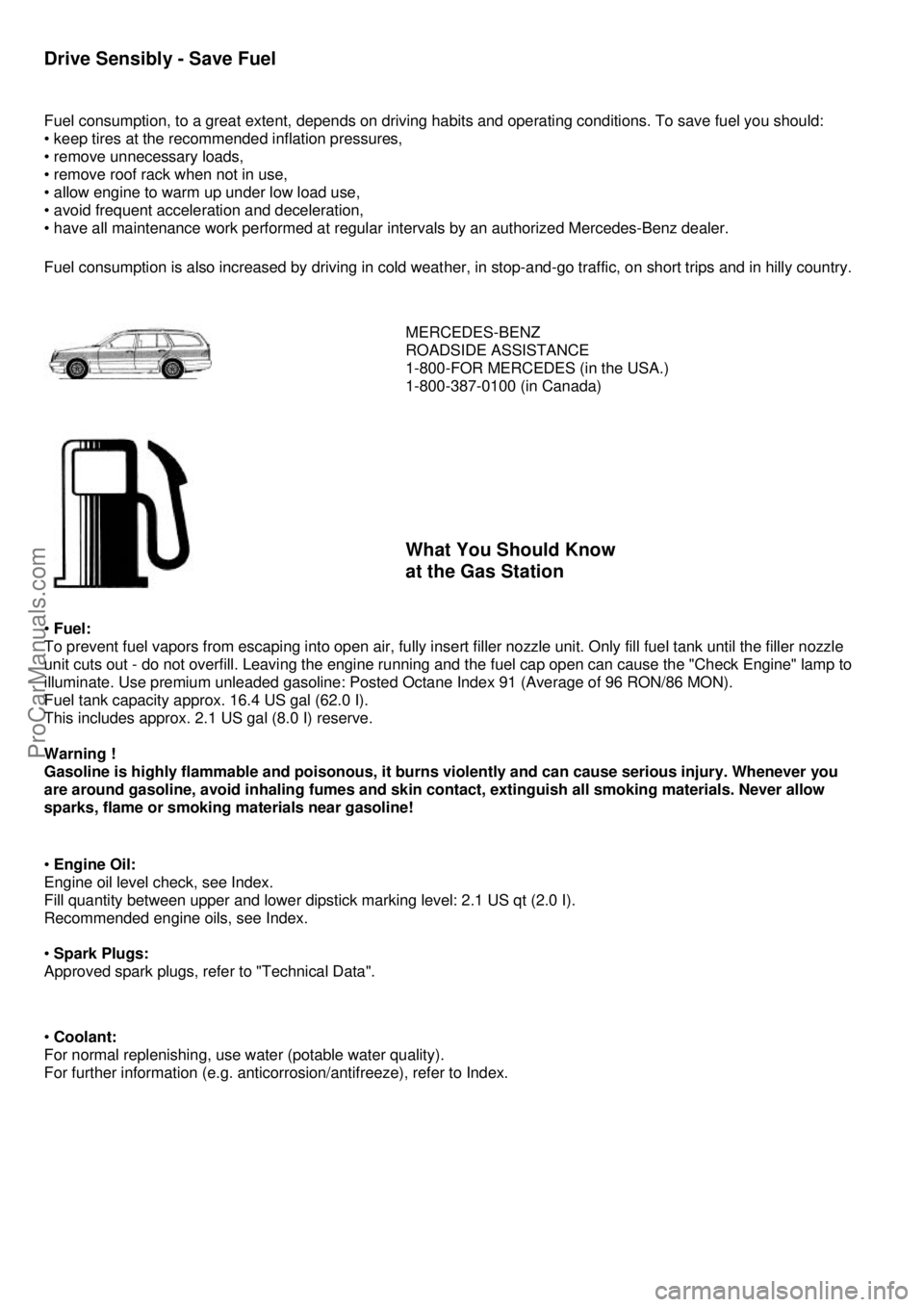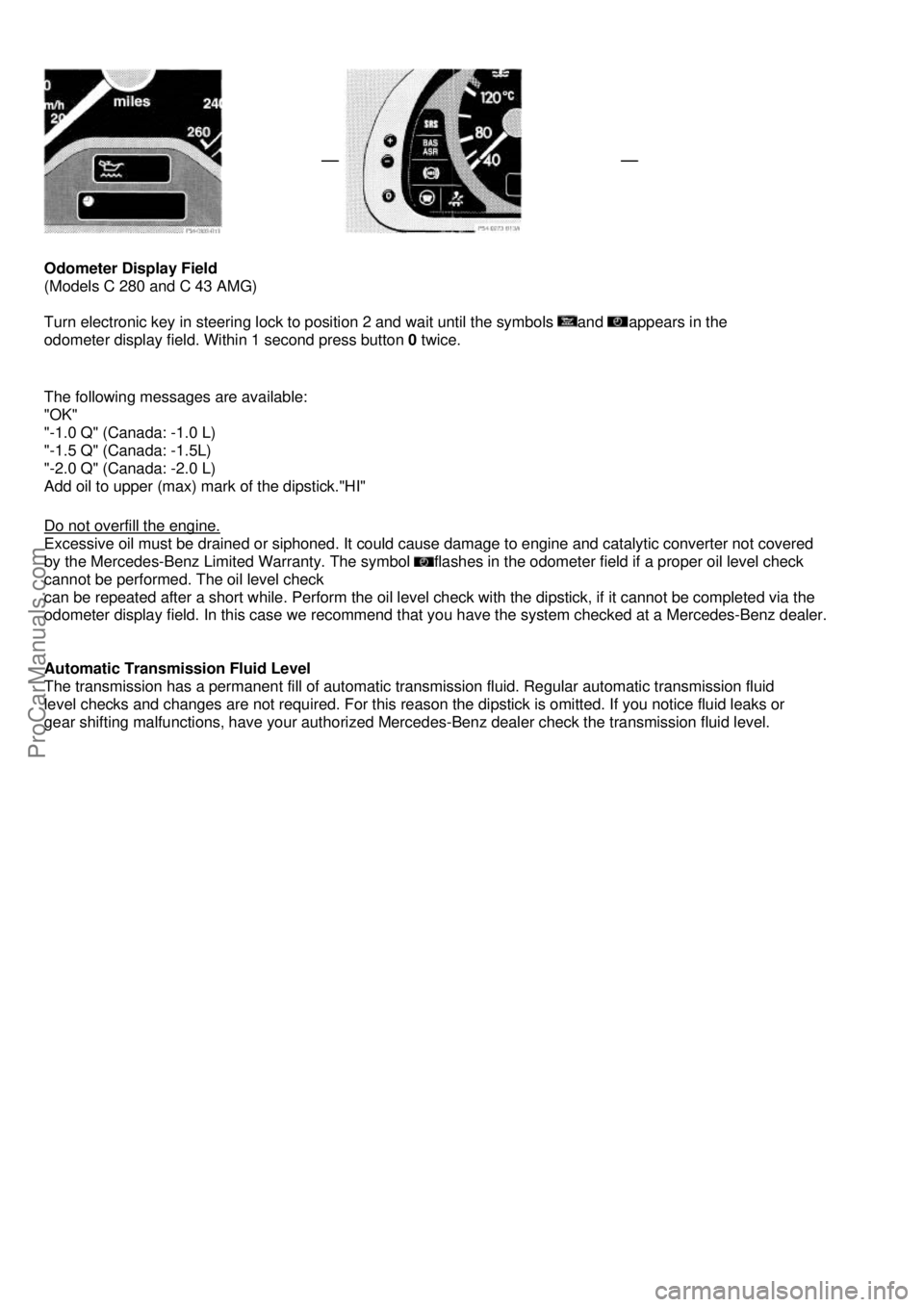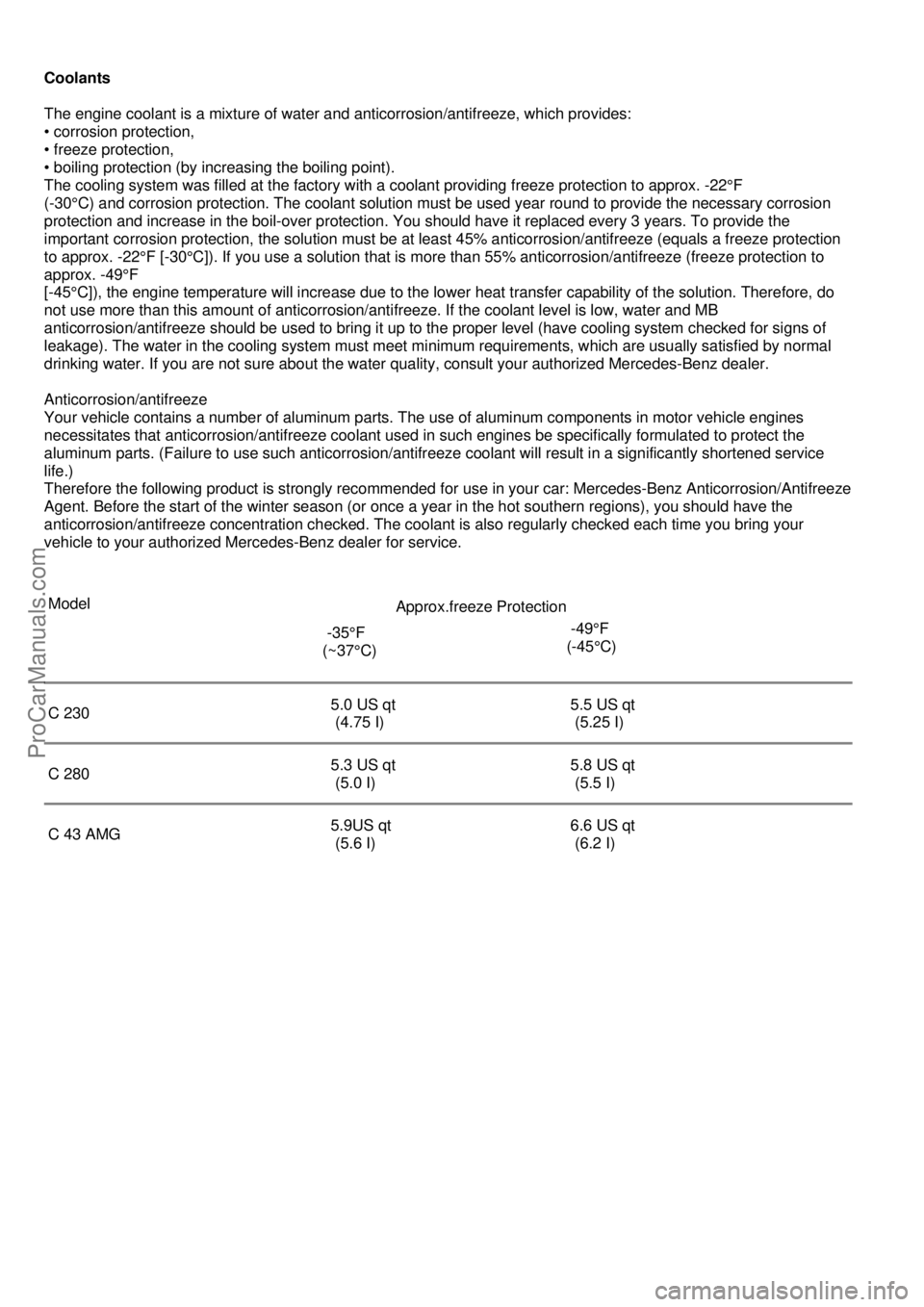check oil MERCEDES-BENZ C-280 1999 Owners Manual
[x] Cancel search | Manufacturer: MERCEDES-BENZ, Model Year: 1999, Model line: C-280, Model: MERCEDES-BENZ C-280 1999Pages: 122, PDF Size: 1.69 MB
Page 1 of 122

Drive Sensibly - Save Fuel
Fuel consumption, to a great extent, depends on driving habits and operating conditions. To save fuel you should:
• keep tires at the recommended inflation pressures,
• remove unnecessary loads,
• remove roof rack when not in use,
• allow engine to warm up under low load use,
• avoid frequent acceleration and deceleration,
• have all maintenance work performed at regular intervals by an authorized Mercedes-Benz dealer.
Fuel consumption is also increased by driving in cold weat her, in stop-and-go traffic, on short trips and in hilly country.
MERCEDES-BENZ
ROADSIDE ASSISTANCE
1-800-FOR MERCEDES (in the USA.)
1-800-387-0100 (in Canada)
What You Should Know
at the Gas Station
• Fuel:
To prevent fuel vapors from escaping into open air, fully inse rt filler nozzle unit. Only fill fuel tank until the filler nozzl e
unit cuts out - do not overfill. Leaving the engine running and t he fuel cap open can cause the "Check Engine" lamp to
illuminate. Use premium unleaded gasoline: Posted Octane Index 91 (Average of 96 RON/86 MON).
Fuel tank capacity approx. 16.4 US gal (62.0 I).
This includes approx. 2.1 US gal (8.0 I) reserve.
Warning !
Gasoline is highly flammable and poisonous, it burns violently and can cause serious injury. Whenever you
are around gasoline, avoid inhaling fumes and skin cont act, extinguish all smoking materials. Never allow
sparks, flame or smoking materials near gasoline!
• Engine Oil:
Engine oil level check, see Index.
Fill quantity between upper and lower dipstick marking level: 2.1 US qt (2.0 I).
Recommended engine oils, see Index.
• Spark Plugs:
Approved spark plugs, refer to "Technical Data".
• Coolant:
For normal replenishing, use water (potable water quality).
For further information (e.g. anticor rosion/antifreeze), refer to Index.
ProCarManuals.com
Page 5 of 122

Indicator Lamp Symbols
Function Indicator Lamp
High beam
Battery not being charged properly.
See Index
Warning Lamps
(should go out with the engine running unless)
Exterior lamp failure. See Index
ASR or ESP.
Adjust driving to road condition. See Index
BAS malfunction. See Index
ASR malfunction. See Index
Fluid level for windshield and headlamp
washer system low. See Index
BAS malfunction. See Index
ESP malfunction. See Index
Coolant level low. See Index
ABS malfunction. See Index
Engine oil level low. See Index Fasten seat belts. See Index
Brake pads worn down. See Index SRS malfunction. See Index
Brake fluid low (except Canada).
Parking brake engaged. See Index
Telescoping steering column not locked.
See Index
Brake fluid low (Canada only).
Parking brake engaged.
See Index
Engine malfunction indicator lamp. If the
lamp comes on when the engine is running,
it indicates a malfunction of the fuel
management system or emission control
system, or the fuel cap is not closed tight. In
all cases, we recommend that you have the
malfunction checked as soon as possible.
See Index
Additional Function Indicator Lamps in
the Instrument Cluster
Function Indicator Lamp on
the Center Console
FSS indicator (distance).
See Index
Passenger Airbag automatically switched
off. See Index
FSS indicator (days).
See Index
ProCarManuals.com
Page 67 of 122

Charge Indicator Lamp
Should the charge indicator lamp fail to come on prior to starting when the electronic key is in steering lock position 2
or should it fail to go out after starting or during operati on, this indicates a fault which must be repaired at an
authorized Mercedes-Benz dealer immediately.
If the charge indicator lamp comes on while the engine is ru nning, this may indicate that the poly-V-belt has broken.
Should this condition occur, the poly-V-bel t must be replaced before continuing to operate the vehicle. Otherwise, the
engine will overheat due to an inoperative water pump which may result in damage to the engine.
Do not continue to drive the vehicle with the charge indicator lamp illuminated. Doing so could result in serious engine
damage that is not covered by the Mercedes-Benz Limited Warranty.
Low Engine Oil Level Warning Lamp
With the electronic key in steering lock position 2, the o il level warning lamp comes on. It should go out immediately
when the engine is running.
If the warning lamp does not go out after starting the engi ne, or comes on with the engine running and at operating
temperature, the engine oil level has dropped to approximately the minimum mark on the dipstick.
When this occurs, the warning lamp will first come on intermittently and then stay on if the oil level drops further.
If no oil leaks are noted, continue to drive to the nearest service station where the engine oil should be topped to the
"full" mark on the dipstick with an approved oil.
The low engine oil level warning light should not be ignored. Extended driving with the light illuminated could result in
serious engine damage that is not covered by the Mercedes -Benz Limited Warranty. In addition to the warning lamp,
the engine oil level should be periodically checked with the di pstick (or via the odometer display - Model 280 only), for
example during a fuel stop, or before a long trip (see Index)
ProCarManuals.com
Page 68 of 122

Engine Oil Consumption
Engine oil consumption checks should only be made after the break-in period. During the break-in period, higher oil
consumption may be noticed and is normal. Frequent driving at high engine speeds results in increased consumption.
Fuel Reserve and Fuel Cap Placement Warning Lamp
With the electronic key in steering lock position 2, the fuel reserve warning lamp comes on. It should go out
immediately when the engine is running.
If the warning lamp does not go out after starting the engine, or if it comes on while driving, it indicates that the fuel
level is down to the reserve quantity of approximately 2.1 gal (8 liters).
The warning lamp blinks when the fuel c ap is not closed, or a fuel system leak has been detected. Retighten cap and
see if lamp goes out.
If the warning lamp continues to blink after closing the fuel cap correctly, hav e the fuel system checked at your
authorized Mercedes-Benz dealer as soon as possible.
Leaving the engine running and the fuel cap open can cause the "Check Engine" lamp to illuminate).
Tachometer
Red marking on tachometer: Excessive engine speed. Avoid th is engine speed, as it may result in serious engine
damage that is not covered by the Mercedes-Benz Limited Warranty. For engine protection, the fuel supply is
interrupted if the engine is operated within the red marking.
Seat Belt Warning Lamp
With the electronic key in steering lock position 2, the warning lamp comes on, and a warning sounds for a short time
if the drivers seat belt is not fastened. After starting the engine, the warning lamp blinks for a brief period to remind
the driver and passengers to fasten seat belts.
ProCarManuals.com
Page 78 of 122

Winter Driving
Have your car winterized at your authorized Mercedes-Benz dealer before the onset of winter.
• Change the engine oil if the engine contains an oil which is not approved for winter operation.
For viscosity (SAE/CCMC class) and filling quantity, see Capacities: Fuels, Coolants,
Lubricants etc. in Index.
• Check engine coolant anticorr osion/antifreeze concentration.
• Additive for the windshield washer and headlamp cleani ng system: Add MB Concentrate "S" to a premixed
windshield washer solvent/antifreeze which is form ulated for below freezing temperatures (see Index).
• Test battery: Battery capacity drops with dec reasing ambient temperature. A well charged
battery helps to ensure that the engine can be started, even at low ambient temperatures.
• Tires: We recommend M+S rated radial-ply tires on all four wheels for the winter season. Observe
permissible maximum speed for M+S rated radial-ply tires and the legal speed limit.
Note:
In winter operation, the maximum effect iveness of the acceleration slip regulation or of the electronic traction system
can only be achieved with M+S rated radial-ply tires and/or snow chains recommended by Mercedes-Benz. Snow
chains maximize performance.
Snow Chains
Use only snow chains that are tested and recommended by Mercedes-Benz. Your authorized Mercedes-Benz dealer
will be glad to advise you on this subject. Chains should only be used on the rear wheels. Follow the manufacturer's
mounting instructions. Snow chains should only be driven on snow covered roads at speeds not to exceed 30 mph
(50 km/h). Remove chains as soon as possible when driving on roads without snow. For tips on driving on slippery
winter roads, refer to Index. Vehicles with Acceleration Slip Regulation (ASR) or Electronic Stability Program (ESP):
When driving with snow chai ns, press the ASR or ESP control switch, refer to Index.
Model C 43 AMG
Important!
Use of snow chains is permissible only on winter tire size 215/45 R 17 H M+S. Refer to "Rims - Tires" in section
"Technical Data" (see Index).
Travelling Abroad
Abroad, there is a widely-spread Mercedes-Benz service network at your disposal. If you plan to travel into areas
which are not listed in the index of your dealer directory, you should request pertinent information from your
authorized Mercedes-Benz dealer.
ProCarManuals.com
Page 81 of 122

Checking Engine Oil Level
Example
1.
Oil dipstick
2. Oil filler cap
To check the engine oil level, park vehicle on level gro und, with engine at normal operational temperature. Check
engine
oil level approximately 5 minutes after stopping the engine, allowing for the oil to return to the oil pan.
Oil Dipstick:
Wipe oil dipstick clean prior to checking the engine oil level. Fully insert dipstick in tube, and remove after three
seconds to obtain accurate reading.
Oil level must be between the
lower (min) and upper (max)
mark of the dipstick.
Fill quantity between upper and lower dipstick markin
g level is approximately 2.1 US qt (2.0 I).
Do not overfill the engine.
Excessive oil must be drained or siphoned. It could cause damage to engine and catalytic converter not covered by
the Mercedes-Benz Limited Warranty.
For low engine oil level warning lamp, see Index.
ProCarManuals.com
Page 82 of 122

Odometer Display Field
(Models C 280 and C 43 AMG)
Turn electronic key in steering lock to position 2 and wait until the symbols
and appears in the
odometer display field. Within 1 second press button 0 twice.
The following messages are available:
"OK"
"-1.0 Q" (Canada: -1.0 L)
"-1.5 Q" (Canada: -1.5L)
"-2.0 Q" (Canada: -2.0 L)
Add oil to upper (max) mark of the dipstick."HI"
Do not overfill the engine.
Excessive oil must be drained or siphoned. It could caus e damage to engine and catalytic converter not covered
by the Mercedes-Benz Limi ted Warranty. The symbol
flashes in the odometer field if a proper oil level check
cannot be performed. The oil level check
can be repeated after a short while. Perform the oil level check with the dipstick, if it cannot be completed via the
odometer display field. In this case we recommend that you have the system checked at a Mercedes-Benz dealer.
Automatic Transmission Fluid Level
The transmission has a permanent fill of automatic tran smission fluid. Regular automatic transmission fluid
level checks and changes are not required. For this reason the dipstick is omitted. If you notice fluid leaks or
gear shifting malfunctions, have your authorized Mercede s-Benz dealer check the transmission fluid level.
ProCarManuals.com
Page 99 of 122

Cleaning and Care of the Vehicle
Warning !
Many cleaning products can be hazardous. Some are poisonous, others are flammable.
Always follow the instructions on the particular container. Always open your car's doors or
windows when cleaning the inside. Never use fluids or solvents that are not designed for
cleaning your car.
In operation, your vehicle is subjected to varying external influences which, if gone unchecked, can
attack the paintwork as well as the underbody and cause lasting damage.
Such damage is caused not only by extreme and varying climatic conditions, but also by air
pollution, road salt, tar, gravel and stone chipping. Grease and oil, fuel, coolant, brake fluid, bird
droppings, insects, tree resins etc. should be removed immediately to avoid paint damage. Frequent
washing reduces and/or eliminates the aggr essiveness and potency of the above adverse
influences.
More frequent washings are necessary to deal with unfavorable conditions; for example, near the
ocean, in industrial areas (smoke, exhaust emissions), or during winter operation.
You should check your vehicle from time to time for stone chipping or other damage. Any damage
should be repaired as soon as possible to prevent the start of corrosion. In doing so, do not neglect
the underside of the car. A prerequisite for a t horough check is a washing of the underbody followed
by a thorough inspection. Damage d areas need to be reundercoated.
Your vehicle has been treated at the factory with a wax-base rustproofing in the body cavities which
will last for the lifetime of t he vehicle. Post-production treatment is neither necessary nor
recommended by Mercedes-Be nz because of the possibility of incompatibility between materials
used in the production proc ess and others applied later.
We have selected car care products and compiled recommendations which are specially matched to
our vehicles and which always reflect the late st technology. You can obtain Mercedes- Benz
approved car care products at your authorized Mercedes-Benz dealer.
Scratches, corrosive deposits, corrosion or damage due to negligent or incorrect care cannot always
be removed or repaired with the car care products recommended here. In such cases it is best to
seek aid at your authorized Mercedes-Benz dealer. The following topics deal with the cleaning and
care of your vehicle and give important "how-to" in formation as well as references to Mercedes-Benz
approved car care products. Additional information can be found in the booklet titled "Car Care".
Engine Cleaning
Prior to cleaning the engine compartment make sure to protect electrical components and
connectors from the intrusion of water and cleaning agents.
Corrosion protection, such as MB Anticorrosion Wax should be applied to the engine compartment
after every engine cleaning. Before applying, all control linkage bushings and joints should be
lubricated. The poly-V-belt and all pulleys should be protected from any wax.
Car Washing
Do not use hot water or wash your car in direct sunlight. Use only a mild car wash detergent, such
as Mercedes-Benz approved Car Shampoo.
Thoroughly spray the car with a diffused jet of wa ter. Direct only a very weak spray towards the
ventilation intake. Use plenty of water an d rinse the sponge and chamois frequently.
Rinse with clear water and thoroughly wipe dry with a chamois. Do not allow cleaning agents to dry
on the finish. If the vehicle has been run through an automatic car wash - in particular one of the
older installations - rewipe the recessed sections in the taillamps (designed to prevent soiling) if
necessary. No solvents (fuels, thi nners etc.) must be used. In the winter, thoroughly remove all
traces of road salt as soon as possible.
When washing the underbody, do not forget to clean the inner sides of the wheels.
Tar Stains
Quickly remove tar stains before they dry and beco me more difficult to remove. A tar remover is
recommended.
Window Cleaning
Use a window cleaning solution on all glass surfac es. An automotive glass cleaner is recommended.
ProCarManuals.com
Page 117 of 122

Coolants
The engine coolant is a mixture of water and anticorrosion/antifreeze, which provides:
• corrosion protection,
• freeze protection,
• boiling protection (by increasing the boiling point).
The cooling system was filled at the factory with a coolant providing freeze protection to approx. -22°F
(-30°C) and corrosion protection. The coolant solution mu st be used year round to provide the necessary corrosion
protection and increase in the boil-over protection. You should have it replaced every 3 years. To provide the
important corrosion protection, the solution must be at leas t 45% anticorrosion/antifreeze (equals a freeze protection
to approx. -22°F [-30°C]). If you use a solution that is mo re than 55% anticorrosion/antifreeze (freeze protection to
approx. -49°F
[-45°C]), the engine temperature will increase due to the lo wer heat transfer capability of the solution. Therefore, do
not use more than this amount of anticorrosion/ant ifreeze. If the coolant level is low, water and MB
anticorrosion/antifreeze should be used to bring it up to the proper level (have cooling system checked for signs of
leakage). The water in the cooling system must meet mi nimum requirements, which are usually satisfied by normal
drinking water. If you are not sure about the water qua lity, consult your authorized Mercedes-Benz dealer.
Anticorrosion/antifreeze
Your vehicle contains a number of aluminum parts. T he use of aluminum components in motor vehicle engines
necessitates that anticorrosion/antifreeze coolant used in such engines be specifically formulated to protect the
aluminum parts. (Failure to use such anticorrosion/antifr eeze coolant will result in a significantly shortened service
life.)
Therefore the following product is strongly recommended for use in your car: Mercedes-Benz Anticorrosion/Antifreeze
Agent. Before the start of the winter season (or once a year in the hot southern regions), you should have the
anticorrosion/antifreeze concentration c hecked. The coolant is also regularly checked each time you bring your
vehicle to your authorized Merc edes-Benz dealer for service.
Model
Approx.freeze Protection
-35°F
(~37°C)
-49°F
(-45°C)
C 230 5.0 US qt
(4.75 I)
5.5 US qt
(5.25 I)
C 280 5.3 US qt
(5.0 I)
5.8 US qt
(5.5 I)
C 43 AMG 5.9US qt
(5.6 I)
6.6 US qt
(6.2 I)
ProCarManuals.com
Page 122 of 122

Check Regularly and Before a Long Trip
The engine compartment of model C 230 is illustrated.
1. Fuel Supply
Open flap by pushing near front (arrow). Turn fuel cap
to the left and hold on to it until possible pressure in tank
has been released, then remove cap.
Failure to remove slowly could result in personal injury.
2. Tire Inflation Pressure
Check at least every two weeks.
For details see Index.
3. Coolant Level
See Adding coolant in Index.
4. Windshield Washer System,
Headlamp Cleaning System
For refilling reservoir see Index.
5. Engine Oil Level
See Index.
6. Brake Fluid
See Index.
Vehicle Lighting: Check function and cleanliness.
For replacement of light bulbs, see Index.
ProCarManuals.com